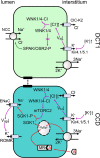Regulation of distal tubule sodium transport: mechanisms and roles in homeostasis and pathophysiology
- PMID: 35895103
- PMCID: PMC9338908
- DOI: 10.1007/s00424-022-02732-5
Regulation of distal tubule sodium transport: mechanisms and roles in homeostasis and pathophysiology
Abstract
Regulated Na+ transport in the distal nephron is of fundamental importance to fluid and electrolyte homeostasis. Further upstream, Na+ is the principal driver of secondary active transport of numerous organic and inorganic solutes. In the distal nephron, Na+ continues to play a central role in controlling the body levels and concentrations of a more select group of ions, including K+, Ca++, Mg++, Cl-, and HCO3-, as well as water. Also, of paramount importance are transport mechanisms aimed at controlling the total level of Na+ itself in the body, as well as its concentrations in intracellular and extracellular compartments. Over the last several decades, the transporters involved in moving Na+ in the distal nephron, and directly or indirectly coupling its movement to that of other ions have been identified, and their interrelationships brought into focus. Just as importantly, the signaling systems and their components-kinases, ubiquitin ligases, phosphatases, transcription factors, and others-have also been identified and many of their actions elucidated. This review will touch on selected aspects of ion transport regulation, and its impact on fluid and electrolyte homeostasis. A particular focus will be on emerging evidence for site-specific regulation of the epithelial sodium channel (ENaC) and its role in both Na+ and K+ homeostasis. In this context, the critical regulatory roles of aldosterone, the mineralocorticoid receptor (MR), and the kinases SGK1 and mTORC2 will be highlighted. This includes a discussion of the newly established concept that local K+ concentrations are involved in the reciprocal regulation of Na+-Cl- cotransporter (NCC) and ENaC activity to adjust renal K+ secretion to dietary intake.
Keywords: 11ß-hydroxysteroid dehydrogenase type 2 (11ßHSD2); Aldosterone; Aldosterone-sensitive distal nephron (ASDN); Connecting tubule (CNT); Cortical collecting duct (CCD); Early distal convoluted tubule (DCT1); Epithelial sodium channel (ENaC); Kinase 1 and 4 (WNK1 and WNK4); Late distal convoluted tubule (DCT2); Mineralocorticoid receptor (MR); Na+-Cl− cotransporter (NCC); Renal outer medullary K+ channel (ROMK); Serum and glucocorticoid-regulated kinase 1 (SGK1); mTOR complex 2 (mTORC2); With no lysine.
© 2022. The Author(s).
Conflict of interest statement
The authors declare no competing interests.
Figures


Similar articles
-
High baseline ROMK activity in the mouse late distal convoluted and early connecting tubule probably contributes to aldosterone-independent K+ secretion.Am J Physiol Renal Physiol. 2022 Jan 1;322(1):F42-F54. doi: 10.1152/ajprenal.00252.2021. Epub 2021 Nov 29. Am J Physiol Renal Physiol. 2022. PMID: 34843658
-
ROMK channels are inhibited in the aldosterone-sensitive distal nephron of renal tubule Nedd4-2-deficient mice.Am J Physiol Renal Physiol. 2022 Jan 1;322(1):F55-F67. doi: 10.1152/ajprenal.00306.2021. Epub 2021 Nov 29. Am J Physiol Renal Physiol. 2022. PMID: 34843409 Free PMC article.
-
Critical role of the mineralocorticoid receptor in aldosterone-dependent and aldosterone-independent regulation of ENaC in the distal nephron.Am J Physiol Renal Physiol. 2021 Sep 1;321(3):F257-F268. doi: 10.1152/ajprenal.00139.2021. Epub 2021 Jul 12. Am J Physiol Renal Physiol. 2021. PMID: 34251271 Free PMC article.
-
[Regulation of kidney on potassium balance and its clinical significance].Sheng Li Xue Bao. 2023 Apr 25;75(2):216-230. Sheng Li Xue Bao. 2023. PMID: 37089096 Review. Chinese.
-
Regulated sodium transport in the renal connecting tubule (CNT) via the epithelial sodium channel (ENaC).Pflugers Arch. 2009 May;458(1):111-35. doi: 10.1007/s00424-009-0656-0. Epub 2009 Mar 11. Pflugers Arch. 2009. PMID: 19277701 Review.
Cited by
-
WNK1 is a chloride-stimulated scaffold that regulates mTORC2 activity and ion transport.J Cell Sci. 2022 Dec 1;135(23):jcs260313. doi: 10.1242/jcs.260313. Epub 2022 Dec 5. J Cell Sci. 2022. PMID: 36373794 Free PMC article.
-
Gi-DREADD activation decreases Epithelial Na+ channel activity in renal principal cells.Physiol Rep. 2025 Jun;13(12):e70433. doi: 10.14814/phy2.70433. Physiol Rep. 2025. PMID: 40526015 Free PMC article.
-
Aldosterone-independent regulation of K + secretion in the distal nephron.Curr Opin Nephrol Hypertens. 2024 Sep 1;33(5):526-534. doi: 10.1097/MNH.0000000000001006. Epub 2024 Jun 18. Curr Opin Nephrol Hypertens. 2024. PMID: 38888034 Free PMC article. Review.
-
Automated patch-clamp recordings for detecting activators and inhibitors of the epithelial sodium channel (ENaC).Pflugers Arch. 2025 Jun;477(6):857-872. doi: 10.1007/s00424-025-03087-3. Epub 2025 May 8. Pflugers Arch. 2025. PMID: 40335709 Free PMC article.
-
The Epithelial Sodium Channel-An Underestimated Drug Target.Int J Mol Sci. 2023 Apr 24;24(9):7775. doi: 10.3390/ijms24097775. Int J Mol Sci. 2023. PMID: 37175488 Free PMC article. Review.
References
-
- Ackermann D, Gresko N, Carrel M, Loffing-Cueni D, Habermehl D, Gomez-Sanchez C, Rossier BC, Loffing J. In vivo nuclear translocation of mineralocorticoid and glucocorticoid receptors in rat kidney: differential effect of corticosteroids along the distal tubule. Am J Physiol Renal Physiol. 2010;299:F1473–1485. doi: 10.1152/ajprenal.00437.2010. - DOI - PubMed
Publication types
MeSH terms
Substances
Grants and funding
LinkOut - more resources
Full Text Sources
Miscellaneous

